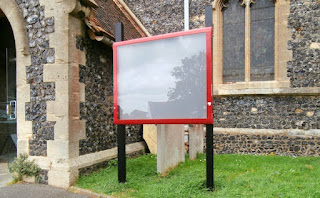If we think back to school, it’s likely we’ll have happy memories of the school notice board. All those fun events, class trips, awards and parties - it really was the centre of attention for so many of us, wasn’t it?
Notice boards are still at the centre of so many people’s lives today too. Schools, hospitals, offices, churches and almost anywhere a group of people congregate looking for information, there are notice boards.
In business and project management, a notice board is almost pivotal to daily meetings, progress updates and sharing information.
Whilst notice boards are seemingly everywhere, the amount of people using them and the variety of uses only seems to grow. This is why the design and types of notice boards have grown also, far past the traditional felt pin board of our nostalgic years.
Let’s take a closer look at the type of notice boards available today, and consider their uses to determine which is right for you.
Framed notice boards
Perhaps the first type of notice board that will spring to most people’s minds are indoor notice boards (just like our trusty school notice board).Available in a range of materials from cork, fabric to felt, indoor notice boards are ideal for open access to a board. Indoor notice boards are usually constructed of a frame fixed to an internal wall.
Indoor notice boards are ideal for workplace signage and announcements, social events or anywhere that one may wish to share information internally (providing they have pins of course!).
With our busy family lives, pin boards are becoming almost commonplace in most kitchens, listing everything from shopping lists to parties. If it can be pinned, it can be fixed to a notice board, hence their popularity in everywhere from homes, shops, schools, and businesses.
Outdoor notice boards
As indoor notice boards are focussed more on internal communication, outdoor notice boards are generally used more for communication outside of a business or property.Typical uses of outdoor notice boards include shop announcements, posters and communications people may need to see outside of business hours.
Designed for durability, outdoor notice boards are typically constructed from metal components and use magnets for fixing notices. Pin boards are sometimes used for outside notice boards, but they are generally freestanding for outdoor use.
Lockable notice boards
Where outdoor notice boards need a little more security - either to prevent tampering of removal of notices, or from adverse weather - lockable notice boards provide an ideal solution.Churches and community centres are ideal examples of how locked notice boards are best used. Access is restricted to the key holder, thus maintaining the integrity and security of the notices. In harsh weather conditions, the notices still stay in place and visible to all.
How to choose an outdoor notice board
When choosing an outdoor board, careful consideration of a few criteria will help select the optimum type.Role of notice board
When you’re choosing notice boards, it helps to have a clear view of what role the board will play, such as :-- local or community information
- company information - just a department, or company wide?
- information for a single team, or will multiple teams have their own section of the board?
- shop or business details
Size of notice board
When planning what size of notice boards are needed, it’s important to consider what size you really need, as they are available in many sizes such as A0, A1, A2, A3, 30” x 20”, 60” x 40” etc.Too big, and any notices look isolated and may even be ignored. A large notice board with empty space is also tempting for anyone to add content, which may encourage over-posting of irrelevant content.
Allow for future expansion - so you don’t need to purchase a bigger board - when you are choosing sizes of notice boards. Good advice is to choose the size you think you need now, then go up one size larger.
Access to notice board
Notice boards need to have controlled access to be effective; either locked to a select key holder or regularly inspected to maintain content integrity.Care must be taken to protect inappropriate or irrelevant content, especially in educational establishments and workplaces, so access is a very important consideration.
However, access control need not be limited just to locked noticed boards. Sometimes simple solutions work just as well, such as not leaving spare pins on a board which will often restrict mischievous posters.
Features of notice boards
Sometimes, notice boards aren’t just for pinning or posting notices. White boards can often be incorporated into notice boards for hand written messages, which are ideal for families and internal communications for instance.Conclusion: which notice board is right for you?
With many different types, sizes and styles of notice boards available, there’s sure to be something to fit every use and budget.Whether it’s a family looking to keep everyone updated, through to community announcements by churches, notice boards are still as popular as ever.
When it comes to business uses of notice boards, anything from a small team through to department and company wide information can benefit from being shared on notice boards.
Following the criteria above to help determine size, features, access and role, you will easily know the type of notice board best suited to your business. Once you’ve decided on your requirements, you can even customise your notice board further with features such as colour or more stylish finishings.
Clearly, a notice board will help you get your message(s) across in a clear and effective manner, whilst also perhaps adding a community spirit, and even a bit of fun.
Why not take a look at all of the notice board options available to you today, and you could be spreading the word as soon as tomorrow?













Comments
Post a Comment